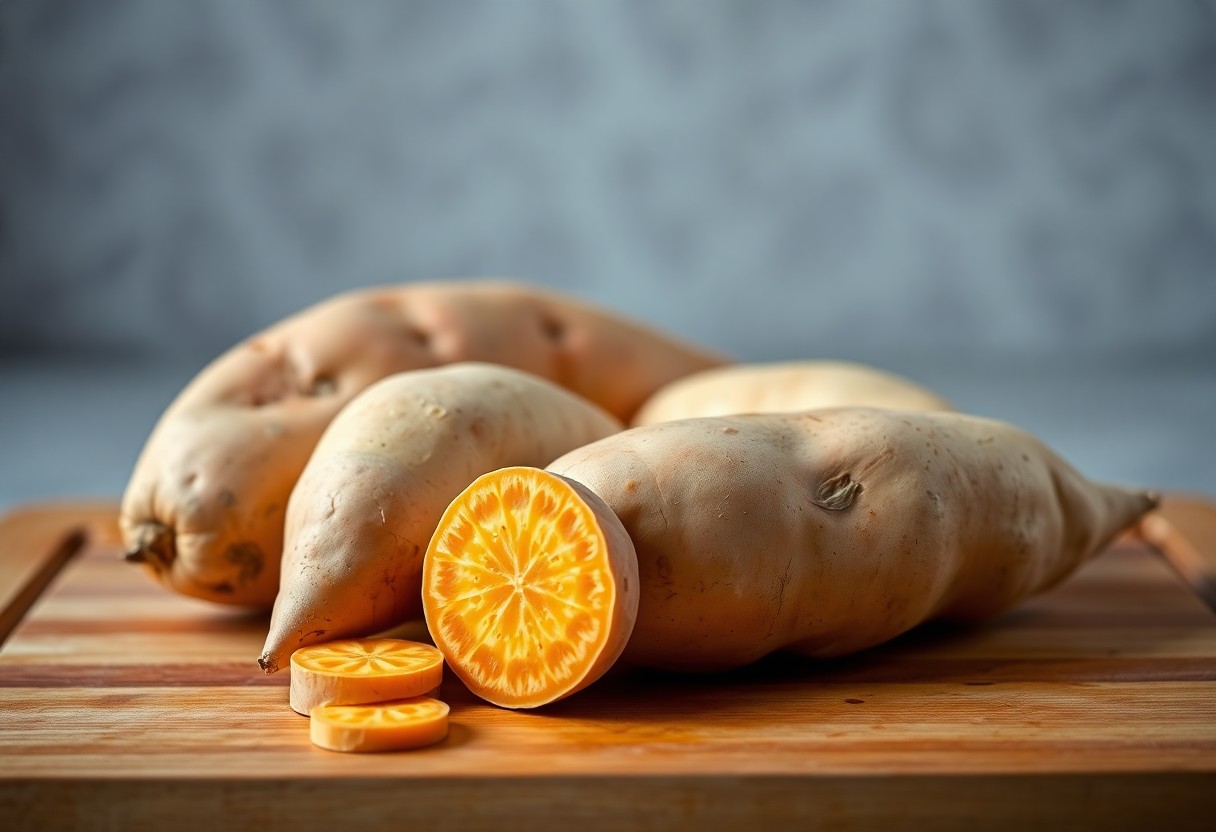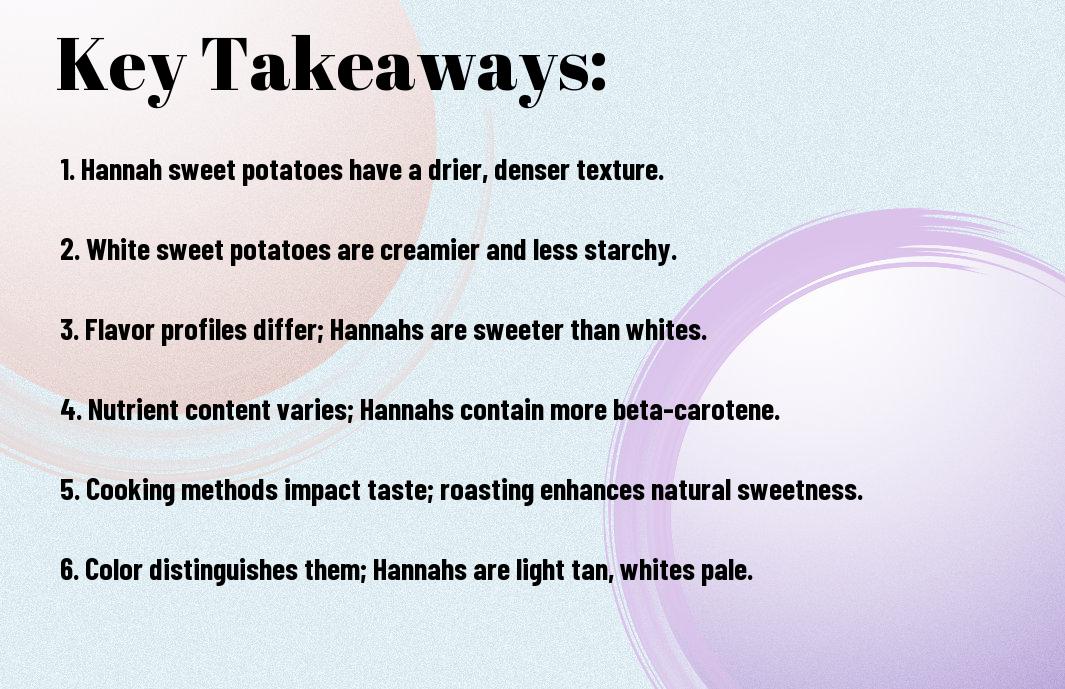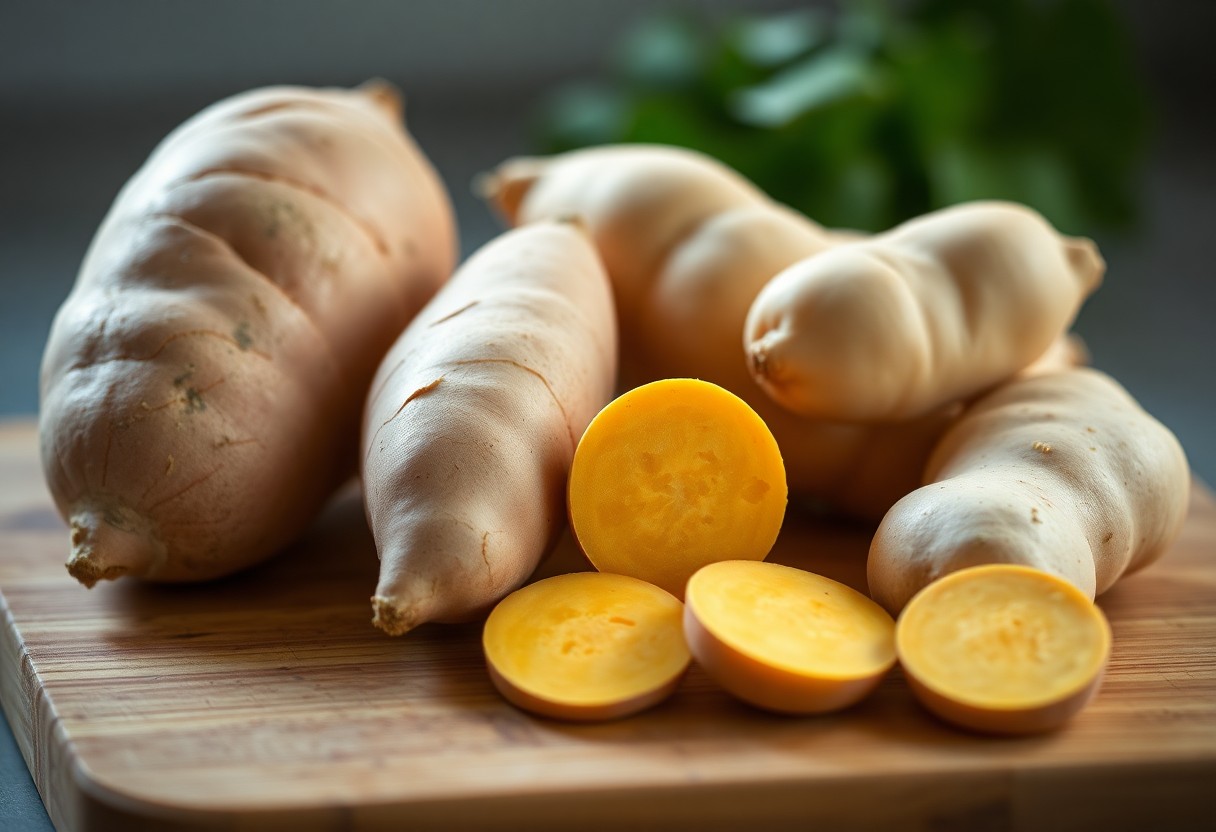Hannah sweet potatoes offer a unique flavor profile that distinguishes them from traditional white sweet potatoes. When you choose Hannah sweet potatoes, you’re opting for a creamier texture and a slightly sweeter taste, making them ideal for various dishes. On the other hand, white sweet potatoes are known for their earthy flavor and starchy consistency, which can be excellent for roasting or mashing. By understanding these differences, you can enhance your cooking experience and select the right type of sweet potato for your meals.

Key Takeaways:
- Hannah sweet potatoes have a lighter, creamier flesh and a drier texture, while white sweet potatoes typically have a sweeter flavor and moist consistency.
- Both types of sweet potatoes are versatile in cooking but may differ in their nutritional profiles, with Hannah sweet potatoes often containing slightly more fiber.
- When choosing between the two, consider the intended taste and texture for your recipes, as they can impact the overall flavor of dishes.
Overview of Sweet Potatoes
Before stepping into the differences between Hannah and white sweet potatoes, it’s necessary to understand sweet potatoes as a whole. They are a nutrient-dense root vegetable, celebrated for their delicious taste and variety of health benefits. Sweet potatoes come in various colors and forms, making them a versatile option for many dishes.
Types of Sweet Potatoes
Between the different varieties of sweet potatoes, you’ll find several types that vary in taste, texture, and appearance. Here’s a breakdown of some popular options:
| Type | Description |
| Hannah | Creamy texture, yellowish flesh, mildly sweet |
| White Sweet Potatoes | Dry and starchy, less sweet than other varieties |
| Orange Sweet Potatoes | Moist, rich flavor, high in beta-carotene |
| Purple Sweet Potatoes | Unique color, earthy flavor, antioxidant-rich |
- Sweet Potatoes are versatile and nutritious.
- Hannah Sweet Potatoes are creamy and mildly sweet.
- White Sweet Potatoes have a drier, starchy texture.
- Orange and Purple Variations offer additional flavors and health benefits.
- Any variety provides unique health benefits, enhancing your meals.
Nutritional Profiles
For those looking to enhance their diets, understanding the nutritional profiles of sweet potatoes is key. Different types offer varying levels of vitamins and minerals, making them unique in their contributions to your overall health.
Potatoes, particularly sweet varieties like Hannah and white, are rich in vitamins, including vitamin A and C, alongside minerals such as potassium. They are also a good source of dietary fiber, which is beneficial for digestive health. White sweet potatoes tend to be drier and less sweet, while Hannah sweet potatoes offer a creamier texture and higher sugar content. Including these in your diet not only enhances taste but also contributes to a balanced nutritional intake.

Appearance and Texture
One of the key distinctions between Hannah sweet potatoes and white sweet potatoes lies in their appearance and texture. Hannah sweet potatoes typically have a smooth, light tan skin with a creamy-yellow flesh that has a slight speckled look. In contrast, white sweet potatoes generally exhibit a pale, off-white skin, encasing a whiter, denser flesh. This variance in appearance also translates to differences in texture when cooked, which can influence your culinary preparations.
Color Differences
Beside the differences in their respective skin tones, the flesh colors of Hannah and white sweet potatoes also set them apart. Hannah sweet potatoes are characterized by their yellowish flesh, while white sweet potatoes boast a much lighter, almost ivory-hued interior that complements their outer appearance. These color variations can enhance the visual appeal of your dishes, making them not only nutritious but also eye-catching.
Flesh Consistency
Color aside, the consistency of the flesh plays a significant role in how you might choose to use these sweet potatoes. Hannah sweet potatoes have a creamier texture when cooked, perfect for mashing or adding into soups. In contrast, the flesh of white sweet potatoes tends to be firmer and denser, offering a satisfying bite that works well for roasting or frying. This variance in flesh consistency can elevate your cooking and provide diverse options for incorporating these ingredients into your meals.
Understanding the flesh consistency of Hannah and white sweet potatoes can greatly influence your cooking methods and recipe choices. While both types can serve as nutritious options in your meals, the creamy texture of Hannah sweet potatoes is ideal for dishes like creamy casseroles or purées, bringing an element of smoothness. Meanwhile, the firmer consistency of white sweet potatoes allows them to hold their shape better in stir-fries or salads, making them versatile for a range of culinary creations. By recognizing these textures, you can effectively enhance your dishes and enjoy both varieties in their best form.
Flavor Profiles
For those exploring the unique flavors of sweet potatoes, understanding the differences between Hannah sweet potatoes and white sweet potatoes is imperative. While both varieties possess a natural sweetness, the Hannah tends to have a more nuanced and earthy flavor, while the flesh of the white sweet potato can be milder and even slightly nutty. This flavor distinction can greatly affect your culinary creations.
Taste Comparison
Below is a concise overview of the taste profiles of Hannah and white sweet potatoes:
Taste Profiles| Hannah Sweet Potatoes | Earthy, sweet, with a creamy texture |
| White Sweet Potatoes | Mild, slightly nutty, and less sweet |
Culinary Uses
Around the kitchen, both Hannah and white sweet potatoes offer versatile options. Hannah sweet potatoes shine in purees, baking, and dishes where their sweetness complements savory ingredients. In contrast, white sweet potatoes are often chosen for roasting and mashing, providing a buttery texture that paired well with spices and herbs.
Consequently, when planning your meals, consider the role each type plays in your dish. Hannah sweet potatoes work wonders in desserts or recipes that benefit from their sweetness, while white sweet potatoes are ideal for savory preparations. Your choice can elevate the overall taste and texture of your meals, providing you with the ability to tailor flavors that suit your preferences and impress your guests.

Cooking Methods
After understanding the differences between Hannah sweet potatoes and white sweet potatoes, exploring their cooking methods will help you achieve the best flavor and texture. Both types can be prepared in various ways, including baking, boiling, roasting, and mashing. Each method brings out unique qualities in the potatoes, making it imperative to choose the right technique based on your desired dish and personal preference.
Preparation Techniques
Methods for preparing sweet potatoes include peeling, cubing, and even leaving the skin on, depending on your preference. When preparing Hannah sweet potatoes, their firmer texture may require longer cooking times, while white sweet potatoes can be sliced or diced for quicker cooking. Always wash your potatoes thoroughly to get rid of any dirt.
Best Practices for Each Type
By knowing the best practices for cooking Hannah and white sweet potatoes, you can enhance their natural flavors. For Hannah sweet potatoes, it’s ideal to bake or roast to retain their moisture and sweetness. In contrast, white sweet potatoes can be boiled or mashed, allowing their creaminess to shine through. Ensure you adjust cooking times accordingly, as each type has different water content.
Type your cooking methods according to the specific potato variety for optimal results. For Hannah sweet potatoes, focus on baking or roasting to maximize their natural sugars and achieve a fluffy texture. Meanwhile, for the white variety, consider boiling or mashing to capitalize on their creamy consistency. Always adjust cooking times, as undercooking can lead to a crunchy outcome, while overcooking can compromise flavor and nutrient density.
Health Benefits
Unlike white sweet potatoes, Hannah sweet potatoes offer a unique blend of nutrients that contribute to a well-rounded diet. They are rich in fiber, vitamins, and antioxidants, which can help enhance your overall health. Incorporating these vibrant tubers into your meals can support better digestion, boost your immune system, and contribute to more stable blood sugar levels.
Nutritional Advantages
Beside the common vitamins found in both types, Hannah sweet potatoes are particularly high in vitamin A and antioxidants, which may help in reducing inflammation and improving eye health. Their higher fiber content can also aid in digestion, making them a favorable option for your meals.
Impact on Diet
Health benefits associated with incorporating Hannah sweet potatoes into your diet include improved digestion and sustained energy levels. These sweet potatoes can help you feel fuller for longer due to their fiber content, reducing overall caloric intake. Additionally, their rich nutrient profile supports your immune system and may lower the risk of chronic diseases.
Benefits of choosing Hannah sweet potatoes over white sweet potatoes can significantly impact your health journey. Their high fiber content not only promotes better digestive health but also aids in weight management, allowing you to maintain a healthier lifestyle. The presence of vitamin A in Hannah sweet potatoes offers important benefits for vision and immune function, while antioxidants can help reduce oxidative stress in your body. Overall, regular consumption can lead to improved health outcomes and greater satisfaction from your meals.
Availability and Selection
Keep an eye out for both Hannah sweet potatoes and white sweet potatoes at your local grocery store and farmers’ market. Availability may vary depending on the season and region, but you can typically find them year-round in many areas. Be sure to select your sweet potatoes from reputable sources that prioritize freshness and quality.
Seasonal Availability
One of the key aspects to consider is that sweet potatoes are generally harvested in late summer to early fall. This means that the best season for purchasing fresh sweet potatoes is typically from September through December, although they can be found year-round thanks to proper storage and distribution methods.
How to Choose the Best Sweet Potatoes
Beside knowing their availability, choosing the best sweet potatoes involves visually inspecting them for quality. Look for firm, smooth skins without any blemishes or sprouts. The weight of the potato is also important; feel for those that are heavy for their size, indicating moisture and freshness.
Due to their popularity, many varieties of sweet potatoes can be found on the market. When selecting your sweet potatoes, prioritize those that are free of soft spots or discoloration, which can indicate spoilage. Pay attention to size; smaller, younger sweet potatoes tend to be sweeter and more flavorful than larger ones. If you’re aiming for a creamier texture, opt for Hannah sweet potatoes, whereas firmer white sweet potatoes are excellent for baking. Your choices can significantly enhance your culinary creations!
To wrap up
On the whole, understanding the differences between Hannah sweet potatoes and white sweet potatoes can enhance your culinary experience and inform your dietary choices. While both offer unique flavors and nutritional benefits, you can choose between them based on your personal taste preferences and the specific recipes you plan to create. Whether you’re looking for a sweet, creamy texture or a milder flavor, knowing these distinctions will help you make the best decision for your meals.
FAQ
Q: What are the main differences in appearance between Hannah sweet potatoes and white sweet potatoes?
A: Hannah sweet potatoes typically have a light tan or beige skin with a pale yellow to creamy white flesh inside. In contrast, white sweet potatoes feature a smooth, light-colored skin that can range from off-white to light tan, and their flesh is usually more white than the flesh of Hannah sweet potatoes. The color difference can help in visually identifying the two varieties.
Q: How do the flavors of Hannah sweet potatoes and white sweet potatoes compare?
A: Hannah sweet potatoes are known for their mildly sweet and nutty flavor, which can become enhanced when roasted or baked. White sweet potatoes have a drier, less sweet flavor compared to Hannah sweet potatoes, with a more earthy taste. This difference in flavor profile makes them suitable for various culinary applications, depending on personal preference.
Q: How do Hannah and white sweet potatoes differ in terms of nutritional content?
A: Both varieties of sweet potatoes are nutritious, but they have slight differences in their nutritional profiles. Hannah sweet potatoes generally have slightly higher carbohydrate and fiber content, which can contribute to their creamier texture. White sweet potatoes, while lower in carbohydrates, still offer a good source of vitamins and minerals, particularly vitamin C and potassium. Eating either variety provides health benefits, and the choice can depend on dietary needs.
Q: Which variety of sweet potato is better suited for specific cooking methods?
A: Hannah sweet potatoes are often preferred for baking and mashing due to their creamy texture and sweet taste, making them a popular choice for sweet potato pies and casseroles. White sweet potatoes hold their shape better during cooking, making them ideal for roasting, frying, or including in savory dishes. Understanding the best uses for each variety can help in cooking them to their best potential.
Q: Are there any significant health benefits associated with consuming Hannah and white sweet potatoes?
A: Yes, both Hannah and white sweet potatoes offer various health benefits. They are excellent sources of complex carbohydrates, dietary fiber, and crucial vitamins like vitamin A (beta-carotene), vitamin C, and B vitamins. Additionally, they contain antioxidants that may help reduce inflammation and promote overall health. By including either variety in a balanced diet, individuals can enjoy these nutritional benefits while exploring versatile culinary options.
